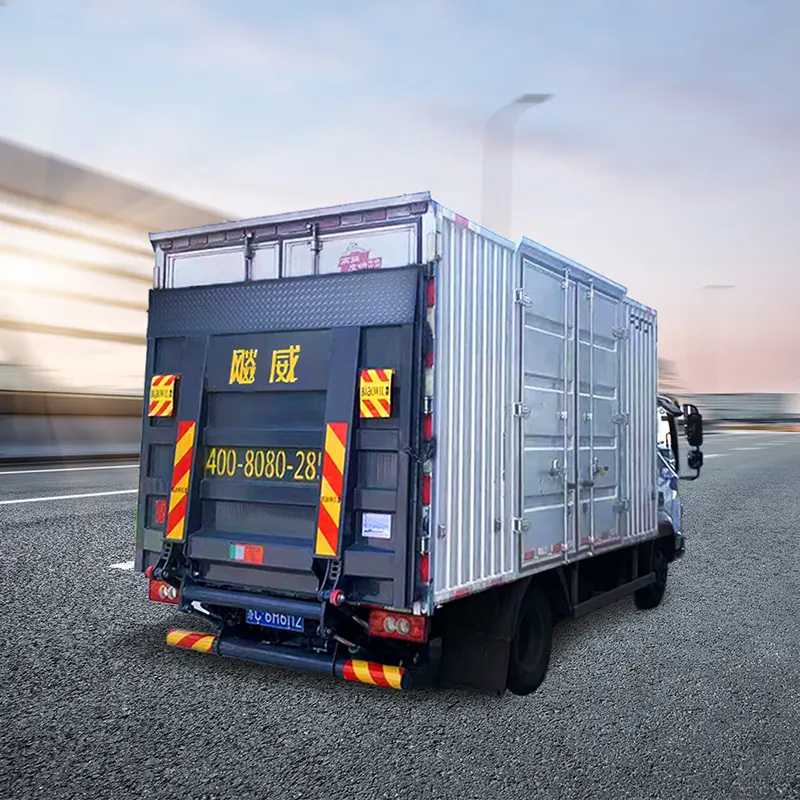Comment fonctionne un lifting de queue?
Anhui-Beauway-Machinery-Manufacturing-Co-ltd-Launches-New-tail-lift-Produit de Products-Improve-the-Wading-and-Unking-Officienté des trucks-trucks et entrepuiseurs-véhicules-véhicules
Un ascenseur à queue est un dispositif mécanique attaché à l'arrière d'un camion ou d'une camionnette, Conçu pour soulever et abaisser les marchandises entre le sol et le lit de chargement du véhicule. Voici une explication du fonctionnement d'un ascenseur de queue, pas à pas:
Composants clés d'un lifting
- Système hydraulique ou pneumatique: Le principal mécanisme qui alimente le levage et la baisse de la plate-forme. La plupart des ascenseurs de queue utilisent l'hydraulique, Bien que certains puissent utiliser des systèmes pneumatiques.
- Unité de contrôle: Un ensemble de contrôles (généralement des boutons ou des leviers) qui permettent à l'opérateur de soulever, inférieur, ou inclinez la plate-forme au besoin.
- Plate-forme de levage: Une surface plane qui maintient la charge pendant le levage ou la baisse.
- Soulever les bras ou les rails: Ceux-ci relient la plate-forme au véhicule et assurent la stabilité pendant le fonctionnement.
- Source d'énergie: The lift typically draws power from the vehicle’s electrical system, often using a battery or alternator to operate the hydraulic pump.
- Safety Mechanisms: These include features like limit switches, pressure relief valves, and overload protection to prevent accidents or equipment failure.
How a Tail Lift Works: Step-by-Step Process
- Deploying the Tail Lift:
Start-Up: The operator activates the tail lift via the control panel, usually located near the rear of the vehicle.
Unfolding the Platform: In types like the tuckaway or slider lifts, the platform is folded under the vehicle. The operator unfolds the platform and positions it flat, ready to load. - Loading the Platform:
Once the platform is fully deployed and positioned at ground level, the operator loads the cargo onto the lift. This can be done manually or with a pallet jack for heavy goods.
The platform can usually handle significant weight, but it has a maximum capacity (often ranging from 500 kg to several tons, depending on the model). - Lifting the Load:
The operator presses the “up” control, activating the hydraulic or pneumatic system. The hydraulic pump forces fluid into the lifting cylinders, which extend the lifting arms or rails, causing the platform to rise.
The platform ascends smoothly to the level of the truck bed. The lift is designed to maintain a stable, level position during the entire process. - Unloading into the Vehicle:
Once the platform reaches the height of the cargo bed, the operator transfers the load into the truck or van.
La plate-forme a souvent des caractéristiques de sécurité comme les rails latéraux ou les surfaces antidérapantes pour empêcher la cargaison de se déplacer ou de tomber. - Abaisser la plate-forme:
Après le déchargement, L'opérateur appuie sur le contrôle «Down». Cela libère la pression hydraulique, Permettre au fluide de retourner dans le réservoir et l'ascenseur pour descendre en douceur.
La plate-forme revient au sol, Prêt pour la charge suivante ou pour être rangé. - Rangeant le lifting de la queue:
Une fois que tout le chargement ou le déchargement est terminé, La plate-forme est repliée dans sa position de stockage (Pour les modèles Tuckaway ou Slider) ou simplement rétracté (Pour les ascenseurs en porte-à-faux et en colonne).
L'opérateur sécurise le lifting de la queue en place, S'assurer qu'il ne bougera pas pendant le transport.
Caractéristiques de sécurité et considérations
Déterminer les commutateurs: These prevent the platform from raising too high or descending too low, protecting both the equipment and the operator.
Overload Protection: If the load exceeds the lift’s rated capacity, the system will not operate, preventing potential damage or accidents.
Pressure Relief Valve: This prevents hydraulic pressure from exceeding safe limits, which could otherwise cause mechanical failure.
Tilting Mechanism: Some tail lifts (like cantilever types) have a tilt function to make it easier to load or unload on uneven surfaces.
Common Applications
Delivery Vehicles: For moving goods in and out of trucks, especially in urban environments where loading docks may not be available.
Construction and Industrial Use: Transporting heavy equipment or materials.
Moving and Relocation: For handling heavy furniture, appliances, or other large objects.
In summary, a tail lift provides a smooth, mechanical solution for loading and unloading heavy goods, making it much easier and safer to handle large items, especially where manual lifting would be difficult or dangerous.

